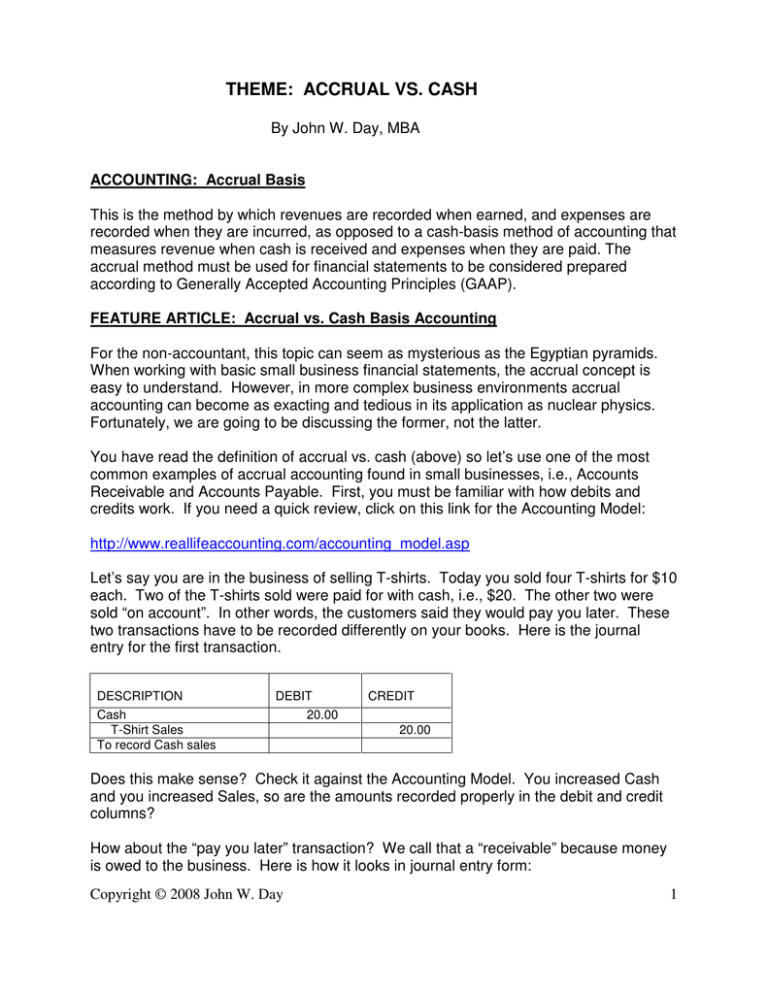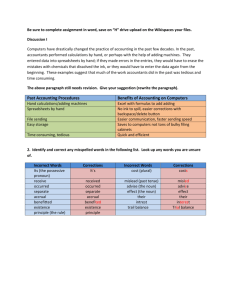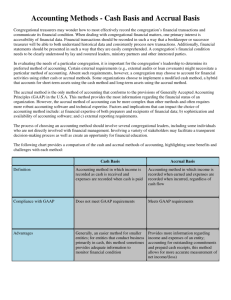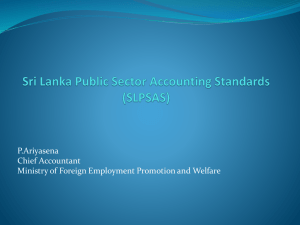THEME: ACCRUAL VS. CASH
advertisement

THEME: ACCRUAL VS. CASH By John W. Day, MBA ACCOUNTING: Accrual Basis This is the method by which revenues are recorded when earned, and expenses are recorded when they are incurred, as opposed to a cash-basis method of accounting that measures revenue when cash is received and expenses when they are paid. The accrual method must be used for financial statements to be considered prepared according to Generally Accepted Accounting Principles (GAAP). FEATURE ARTICLE: Accrual vs. Cash Basis Accounting For the non-accountant, this topic can seem as mysterious as the Egyptian pyramids. When working with basic small business financial statements, the accrual concept is easy to understand. However, in more complex business environments accrual accounting can become as exacting and tedious in its application as nuclear physics. Fortunately, we are going to be discussing the former, not the latter. You have read the definition of accrual vs. cash (above) so let’s use one of the most common examples of accrual accounting found in small businesses, i.e., Accounts Receivable and Accounts Payable. First, you must be familiar with how debits and credits work. If you need a quick review, click on this link for the Accounting Model: http://www.reallifeaccounting.com/accounting_model.asp Let’s say you are in the business of selling T-shirts. Today you sold four T-shirts for $10 each. Two of the T-shirts sold were paid for with cash, i.e., $20. The other two were sold “on account”. In other words, the customers said they would pay you later. These two transactions have to be recorded differently on your books. Here is the journal entry for the first transaction. DESCRIPTION DEBIT Cash T-Shirt Sales To record Cash sales CREDIT 20.00 20.00 Does this make sense? Check it against the Accounting Model. You increased Cash and you increased Sales, so are the amounts recorded properly in the debit and credit columns? How about the “pay you later” transaction? We call that a “receivable” because money is owed to the business. Here is how it looks in journal entry form: Copyright © 2008 John W. Day 1 DESCRIPTION DEBIT Accounts Receivable T-Shirt Sales To record accrual sales CREDIT 20.00 20.00 Sales are said to be “accrued” when the payment for the goods or services is deferred to a later date. But, you might ask: Why are both the Cash and Accounts Receivable amounts listed in the debit column? It should be obvious that the General Ledger (GL) Sales account belongs in the Revenue section, but what section do the GL accounts, Cash and Accounts Receivable belong? They are Assets. Why? Because both of the items represent an economic resource that your company has possession and control over that will provide a future benefit. What happens when an Asset is increased? The Accounting Model tells us that an increase of an Asset belongs on the “debit” side of the ledger. Thirty days later your customers send you checks totaling $20 to pay for the T-Shirts. Here is how the transaction is booked: DESCRIPTION DEBIT Cash Accounts Receivable To record Cash “received on account” (ROA). CREDIT 20.00 20.00 What happened here? You received $20 Cash, put it in the bank, and you eliminated or canceled out the amount owed to you on the books. Let’s look at Accounts Payable next. In this situation, we will assume that you bought some inventory (T-Shirts) for resale. You bought four T-Shirts altogether. You paid cash for two shirts and the other two you bought “on account”. Here is what it looks like in journal entry form: DESCRIPTION DEBIT Inventory Cash To record cash purchase of T-Shirts DESCRIPTION CREDIT 20.00 20.00 DEBIT Inventory Accounts Payable To record purchase of TShirts on account. Copyright © 2008 John W. Day CREDIT 20.00 20.00 2 In both cases you purchased Inventory, but in the first case, you decreased Cash (an Asset) and in the second case you increased a Liability (you owe someone money). Do these journal entries square with the Accounting Model? Notice that you are done with the Cash transaction but not the Payable transaction. Some day you are going to have to pay the vendor for the T-Shirts. When you do, the journal entry will look like this: DESCRIPTION DEBIT Accounts Payable Cash To record payment “on account”. CREDIT 20.00 20.00 You decreased the Liability and decreased Cash. These are examples of the difference between an Accrual transaction and a Cash transaction. Which one is better? It is not a question of better, it is a question of accuracy. If you include all accrual transactions on your books, the reader will have a more complete understanding of what is going on in your business than if only Cash transactions are recorded. Think about it with our examples. The Accrual transactions would show more Assets, more Liabilities and more Revenue than the strictly Cash transactions. This reflects all the activity going on instead of just a portion. This is why the Financial Accounting Standards Board (FASB) requires that financial statements that are prepared using Generally Accepted Accounting Principles (GAAP) use the Accrual method of accounting. QUESTION: Can I Use Accrual for My Books and Cash for My Taxes? Yes! People do it all the time. However, you must remember to adjust your accruals to cash at the end of the year. If you are using a full accrual system, then it may not be practical to have to change over everything from accrual to cash. If you are using a hybrid system (explained in the Tip of the Month) then all you have to do is adjust your Accounts Receivable and Accounts Payable balances at the end of the year. For example, let’s say you generated $75,000 in Revenue during the year. Your Accounts Receivable balance happens to be $25,000 on December 31. The logical conclusion is that you had $50,000 in cash receipts that are reportable on your tax return. The following year you had $100,000 in Revenue but your Accounts Receivable balance was only $10,000. In this case, your reportable cash receipts would be $115,000. Why? Twenty-five thousand in cash was received in the current year but was generated in the prior year and $90,000 was received in the current year and generated in the current year. Copyright © 2008 John W. Day 3 Cash received from the prior year New Sales Revenue current year Less: Current year’s Accounts Receivable Total Cash received current year $ 25,000 100,000 125,000 -10,000 $115,000 When adjusting Accounts Payable for a cash basis tax return, you have a choice. You can remove all the expense items that relate to Accounts Payable such as: DESCRIPTION Accounts Payable Cost of Goods Sold Telephone Accounting Utilities Advertising Outside Services Repairs & Maintenance To adjust Accounts Payable items for Cash Basis Tax Return. DEBIT CREDIT 5,000.00 1,500.00 50.00 100.00 200.00 1,500.00 1,000.00 650.00 Or, you can do this by setting up a special account: DESCRIPTION DEBIT Accounts Payable Accounts Payable Adjust To adjust Accounts Payable items for Cash Basis Tax Return. CREDIT 5,000.00 5,000.00 Either way, the point is that you can do it and there may be good reason to do so. You may have high receivables and low payables. This means you could be in for a double-whammy. You will have to report high income and low deductions. This means your taxes will be higher while not having received the cash to pay those taxes. Keep in mind though that you can’t switch back and forth each year from accrual to cash. Once you select the method of accounting for your tax return, you have to stick with it. Otherwise, you will have to have permission from the IRS and a very good reason for requesting a change in accounting method. TIP: Simplify and Use a Hybrid System. Many people use a hybrid system. This means using a combination of accrual and cash basis methods when preparing financial statements. Most often, a business will Copyright © 2008 John W. Day 4 record only Accounts Receivable and Accounts Payable accrual items. In addition, the only Accounts Payable items recorded will be Inventory purchases, since most of the other expenses of the business are paid within 30 days. The value of using the hybrid system is that your financial statements reflect all Revenue and all Inventory purchases. Plus, it is fairly straightforward when adjusting for a cash basis tax return at the end of the year. John W. Day, MBA is the author of two courses in accounting basics: Real Life Accounting for Non-Accountants (20-hr online) and The HEART of Accounting (4-hr PDF). Visit his website at http://www.reallifeaccounting.com to download his FREE ebook pertaining to small business accounting and his monthly newsletter on accounting issues. Ask John questions directly on his Accounting for Non-Accountants blog. Copyright © 2008 John W. Day 5





